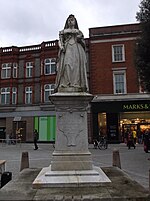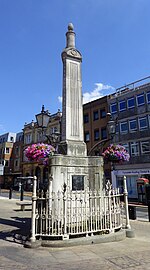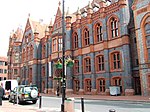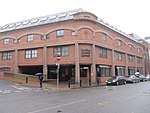The Simeon Monument, also known as the Soane Obelisk, the Soane Monument and the Simeon Obelisk, is a stone structure in Market Place, the former site of the market in Reading, Berkshire. It was commissioned by Edward Simeon, a Reading-born merchant who became extremely wealthy as a City of London trader. Edward Simeon's brother, John, was a former Member of Parliament for Reading who had lost his seat in the 1802 elections to the parliament of the newly created United Kingdom of Great Britain and Ireland, since which time the family had been engaged in ostentatious spending locally in an effort to gain support among the town's voters.
Although street lighting had been installed in Reading in 1797, the system used was one of lamps attached to the sides of buildings and as a consequence open spaces remained unlit. In 1804 Simeon persuaded the Mayor of Reading that it would be of benefit to erect a structure in Market Place, which would serve both to carry lamps to light the area and to improve the flow of traffic in the area, and volunteered to pay for such a structure himself.
Simeon commissioned local architect John Soane to design a suitable structure. Soane designed an unusual triangular structure, 25 feet (7.6 m) high and built of Portland stone. It had no official unveiling or opening ceremony, but the stonework was complete by September 1804. The structure was immediately controversial, denounced within weeks of its opening as "a paltry gew-gaw thing without use, or name", built by Simeon to promote himself rather than for the public benefit. In early 1805 Simeon donated an annuity of 3% interest on £1000 to pay for the lamps on the obelisk to be lit in perpetuity.
By 1900 a cabmen's shelter had been erected next to the monument, and in 1933 underground public toilets had been built alongside it. Although Simeon had stipulated that the lamps were to remain lighted forever, by this time the lamps were no longer operational, having been replaced by baskets of flowers in 1911. Although the monument was Grade II listed in 1956, by this time it was becoming extremely dilapidated. The market was relocated away from Market Place in the 1970s, and the obelisk avoided demolition primarily owing to lobbying by admirers of Soane, as it was the last surviving structure in Reading to have been designed by him.
In 2005, Reading Borough Council agreed to landscape Market Place and to renovate the Simeon Monument. The now-disused toilets and other structures around the monument were removed, and the monument itself was restored to its former condition.












